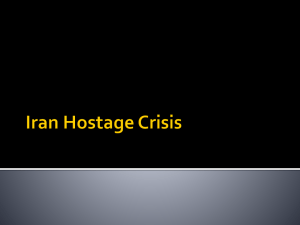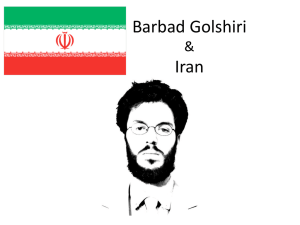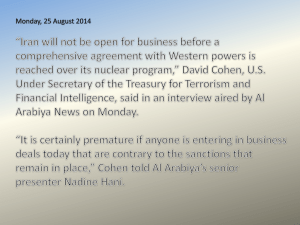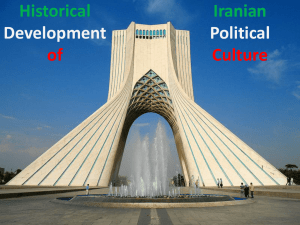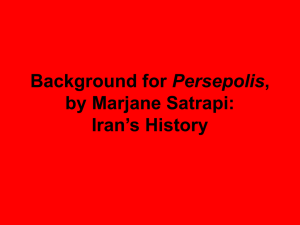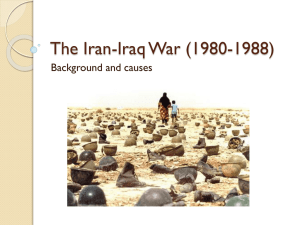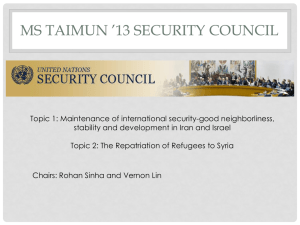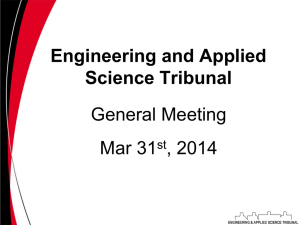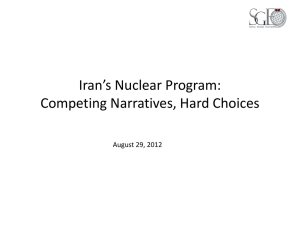Overview of the Iran United
advertisement
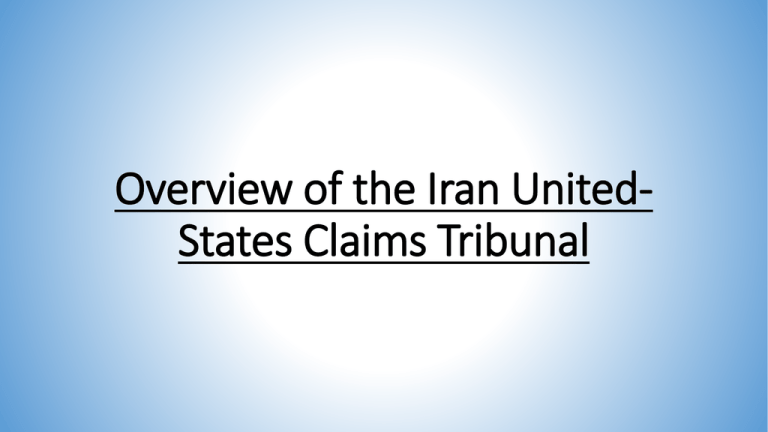
Overview of the Iran UnitedStates Claims Tribunal A. Background: 1. Iranian Revolution • The 1970s saw dramatic changes in Iran and in relations between Iran and the USA. (Here: Explain why the revolution happened in Iran, with references to the 1905 Constitutional Revolution, and the 1952 Nationalization of the Oil Industry in Iran and Coup d’etat of the 1952 which toppled the popular Government of Dr. Musadeq and defeated Iranian Nationalism). The so called “dramatic changes” increased the power of the OPEC countries including Iran, and as a consequence, increased the flow of funds to these countries, which resulted in rising oil prices and changes in international relations with the big oil companies of the world. Iran’s wealth attracted foreign investments and this fortune of the OPEC nations including Iran, created a recycling of “petro-dollars”. Thousands of American companies opened offices in Iran, created a lot of opportunities for business contracts, reconstruction and technology transfers, and therefore, thousand of American military and civilian advisors and experts flow into Iran following the huge importing of military equipment and goods purchased by Iran, especially in the republican periods and within the frame of the Foreign Military Sales Program (particularly in Nixon and Ford administrations). • America had two goals during those years: Financial benefits, and, more importantly, strategic reasons. The Shah of Iran was also pleased to have his country as the strongest and the most stable country in the region, and pleased to have stability in the oil-rich Persian Gulf. This situation resulted in thousands of Iranian citizens immigrating to the USA. Most of them acquired US nationality and returned to Iran for business opportunities and families reasons. The Shah, who was interested that Iran financially invests in some major projects, to facilitate the American presence in many oilfields same offshore oil drilling off the Persian Gulf and forestry projects near the Caspian Sea. This was done through the construction of new roads, airports (including Tehran International Airport), shipping, transportation, hotels, banks, insurance companies, consumer products and agricultural commodities. Between 1973 and 1977 Iran signed a series of agreements to purchase more than USD 12 billion in military and nonmilitary goods and services. Also, by the late 1970s up to 45,000 American citizens were living in Iran. Hundreds of foreign joint ventures and American firms were established in Iran. By the beginning of 1977, opposition to the Shah is mounting and social and political unrest is raising leading to demonstrations, strikes, and civil strife. In January 1979, the Shah left Iran, and on 01 February 1979 the religious leader, Ayatollah Ruhollah Khomeini returned from exile (Here: a short discussion on Khomeini’s life and thoughts). • On 11 February 1979 Khomeini proclaimed the Islamic Republic of Iran and established a new provisional government. (Here: reference to Engineer Bazagan, the first PM of the IR of Iran). The provisional government began the implementation of reforms that heavily impacted on the business interests of foreign companies, particularly American companies. A part of these reforms was the nationalization of banking and insurance. The oil industries already were de facto nationalized in 1952. The other part of the new government’s reforms, was the expropriation of property of American companies, and cancellation of government contracts with American firms. Some American experts believed that life in Iran started to become more difficult for American expatriates during the events of 1978 and early 1979 when the Shah was toppled and Islamic Republic of Iran replaced the Pahlavi dynasty. Later, when the American’s left Iran they would claim this situation as evidence to the courts and the future Iran US Claims Tribunal. • There were some anti-western slogans during the revolution but neither any American or Western nationals were killed or even injured by the revolutionary action. However, the Americans suspended their activities by December 1978 and either by their own decision or by the direct or indirect threat, left Iran (Here: compare with Nicaragua Revolution). 2. Hostage crisis • The situation was not so bad until the seizure of the American Embassy on 4 November 1979 by the “students”, or “Iranian Militant” and the endorsement of that action by the Iranian leadership. The students demanded the return of the Shah to Iran along with his assets. • As previously referenced, between this series of events after Iranian Revolution, the most noticeable was the hostage crisis, which resulted in legal cases before the Iran US Claims Tribunal. During the hostage crisis 52 American nationals were detained, most of them with diplomatic status, who served in the USA Embassy in Tehran. • Referring to the chronology of events helps us to better understand the hostage crisis. On 22 October 1979, the Shah is admitted to the USA for medical treatment. Iran suspected that America was using the same plan as in 1952, when CIA toppled Iranian government and brought the Shah back to power. • A short time after the student’s action, Iran threatened to withdraw its assets from American banks. In response to the hostage crisis and Iranian’s threat, President Carter, imposed economic sanctions on Iran on 14 November 1979. Consequently, Iranian assets in the USA and in American financial institutions abroad (around USD 8 billion) were frozen. American companies thought this was the moment to raise their claims in connection with all financial damages and losses of property in Iran. The American companies and citizens whose interests were affected by the Iranian Revolution bring a breach-ofcontract and expropriation claim against Iran in USA courts. They frequently also seek the attachment of the Iranian frozen assets. Over 400 lawsuits were pending against Iran in American law courts with approximately USD 4 billion of Iranian assets claimed. In short, deadlock. The America government had a hostage problem and Iran faced financial sanctions. • The negotiations of the both countries began through the Government of Algeria in the Autumn of 1980. (Here: reference to the previous records of the Algerian “Good Office” between Iran and Iraq in the Shah period). Both parties agreed to resolve their current problems finally by the Algerian Declarations of 19 January 1981. (Here: Short discussion on the texts of both Declarations and distribution handouts of both texts). The American hostages freed after 444 days. They left Iran for the USA, and Iranian assets were managed according to the Algerian Accords. • The hostage crisis is an important event in both International Law and International Relations and also effected diplomatic trends. The Soviet Union’s response to this crisis also is an interesting final chapter of the cold war. The presence of leftist groups in Iran and especially the “Tudeh Party” of Iran, had big effects on internal and international policies of the Revolutionary Government of Iran. B. Algerian Accords A few points: • The hostage crisis ended by the mediation of the Government of Algeria. To settle all problems, the two Governments adhered to the Algiers Declarations. This is a package of declarations and announcements. We have two main Declarations: (1) General Declaration, and (2) Claims Settlement Declaration. The first document records central commitments of the both parties. The second one is an arbitration agreement which established the IranUnited States Claims Tribunal. The Minister of Foreign Affairs of the Government of the Democratic and Popular Republic of Algeria, Mr. M. Benyahia was directly involved in the parties negotiations. • By the Algeria Accords and the release of the hostages, Iran was entitled to obtain its assets previously frozen in the USA. The USD 8 billion had been placed in escrow by the USA to be transferred in part to Iran and in part to two other accounts. One of these two accounts was with the FED and another was with the Bank of England. These two accounts received USD 5 billion to cover anticipated bank claims and syndicated Iranian bank loans and any other Iranian debts to US banking institutions. Another USD 1 billion was transferred to a Security Account to secure and pay claims against Iran, and the reminder of the assets were transferred to Iran. Iran has an obligation to have no less than USD 500 million in a security account located in Amsterdam, with the provision that this security account is not used to pay awards in favor of Iranian claimants. General Declaration: • This Declaration has a “General Principles”, and four points. By this Declaration, Iran undertook to bring about the release of the 52 hostages. The US undertook to (1) terminate all litigation against Iran in US courts involving certain claims and to nullify attachments, (2) not intervene in internal affairs of Iran, (3)return Iranian financial and tangible assets, (4) provide certain assistance to Iran in bringing about the return to Iran of the assets of the former Shah and his close relatives. Claims Settlement Declaration or CSD: • CSD has eight Articles and established the Tribunal as the mechanism for bringing about the resolution of claims through binding arbitration. It means, that from the US prospective, the Tribunal is a substitute forum for the US courts. The CSD deals, amongst other things, with jurisdiction, constitute of the Tribunal, and applicable law. Other parts of the Algiers Accords: • The Escrow Agreement was signed between US and the FED (the Federal Reserve Bank of New York); and Central Bank of IR of Iran; and Central Bank of Algeria as Escrow agent, signed on 20 January 1981. • The Technical Agreements, between Central Bank of Algeria as Escrow agent, and the Government and company of the Bank of England and the FED, signed on 20 January 1981. • Exchange of Notes between the Kingdom of the Netherlands and the USA, dated 10 July 1981. • Technical Agreement with “de Nederlandsche Bank B.V.”, dated 17 August 1981. • Technical Agreement with “N. V. Settlement Bank of the Netherlands, dated 17 August 1981. • Supplement Agreement, 28 February 1981 • Supplement Agreement, 31 August 1981 C. Establishment of the Iran-US Claims Tribunal at The Hague General points: • The representatives of Iran and US (M. Karim Eshragh and Arthur Rovine) met on 18 May 1981 for the first time. This meeting was held in the Peace Palace, The Hague , Netherlands. The two countries had no diplomatic relations and this event was a very important step to getting the arbitration tribunal started. At the same time, three appointed arbitrators from each side met for the first time in the same place and they could select three neutral arbitrators. After crucial and difficult negotiations but with mutual agreement: two arbitrators from Sweden, and one from France were selected. The full Tribunal (combined of the nine Judges) holds its inaugural session in the Peace Palace on 01 July 1981. Both Agents gave interviews and made press releases. The two Agents agreed on the location of the headquarters of the Tribunal, and the official languages to be used (Persian and English) and also the distribution of the positions at the Tribunal. Finally, the organization of the tribunal settled. The selected Swedish President of the Tribunal, Judge Gunar Lagergren, managed the approval of the Rules of the Tribunal by the full Tribunal. This was done by modifying the “UNCITRAL Rules”. The role of the UNICITRL was mentioned in the Claims Settlement Declaration. The first statements of claim are received on 20 Oct 1981. The deadline for the submission of claims from both sides is fixed for 19 January 1982. The office of the Tribunal was moved from the Peace Palace to its present rented location on 22 April 1982. Organization of the tribunal: • Tribunal has three chambers each chamber combined of the three Arbitrators, one Iranian, one American and one neutral (“thirdcountry”). According to the modified UNCITRAL rules of the Tribunal, if the Iranian and American arbitrators could not reach agreement on the selection of the neutral arbitrators, then an Appointing Authority appoints the three third-country members. One of the third-country members acts as the President. • The expenses of the Tribunal shall be borne equally by the two governments and at this moment is about yearly USD 7 million. • The Tribunal has a registry headed by two registrars: one Iranian and one American. Totally, almost 4,000 claims have been filed to date. Of these cases, 2,500 claims were categorized as “small claims” and settled as a package by the Airbus case which was submitted to the ICJ by Iran against the USA Government. The 17 cases remaining, are specifically between the two Governments. The total claim of the American nationals was about USD 40 billion and from the Iranian side was about USD 20 billion. The most sessions of the Tribunal hearings were between 1982 to 1983 by 55 hearings. The most issuing awards of the Tribunal were 84 awards in 1983 and 1984. • The two Governments shall designate an agent at the seat of the Tribunal. The Agents functions included: • 1) representing the position of their government to the Tribunal, • 2) conducting informal negotiations on general procedural and administrative matters, • 3) consulting with claimants/respondents, • 4) conducting negotiations with the Host Country, • 5) holding discussions with the Appointing Authority, • 6) reporting developments at the Tribunal to their respective authorities, • 7) conducting settlement negotiations, and • 8) coordinating various social engagements. Cases in Tribunal • The Tribunal shall decide all cases on the basis of respect for the law, applying such choice of law rules and principles of commercial and international law as the Tribunal determines to be applicable, taking into account relevant usages of the trade, contract provisions and changes of circumstances. D. Conclusion • From the American perspective, “The Tribunal has already had great influence on the process of international claims resolution. The Tribunal shows that law-based institutions can provide a measure of justice in the face of grave upheavals in international relations”. • From the Iranian perspective, “The whole operation of arbitral decision making, especially given such a magnitude of claims , is an interaction of “man’s mind, culture and understanding”. • The Tribunal has set a precedent and illustrated the power of the pen over the bullet. Thank you for your attention.
